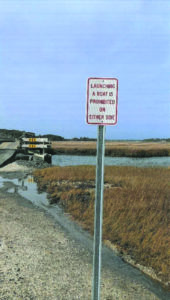WELLFLEET — Dick Elkin looked out the window of his home on Catboat Road on the morning of Nov. 4 and saw DPW workers installing signs at the entrance to the Lieutenant Island bridge. The signs said, “Launching a boat is prohibited on either side.”

Elkin approached one of the workers, who told him that “he didn’t know why he was putting them up — his boss just told him to,” Elkin recalled. Elkin then phoned the DPW and was told the directive originated with the town’s health and conservation dept.
It turned out the department had received numerous complaints from members of the Lieutenant Island Association, a group of homeowners on the island, telling of marsh damage from trailers and cars parked along the road, Town Administrator Rich Waldo told the select board during its Nov. 15 meeting.
When Conservation Agent Hillary Greenberg-Lemos went to inspect the marsh around the bridge where kayakers launch their boats, she noted “major rutting from tire tracks and eroding shoulders of the roadway,” DPW Director Jay Norton told the Independent. The conservation dept. then asked the DPW to install the signs.
After the signs went up, the town received a dozen emails from residents across the Cape protesting what they say is, in effect, a ban on kayaking. Elkin, who is a member of the Nauset Newcomers Kayaking Club, wrote one of those emails.
“This location has been one of Wellfleet’s most popular kayak launching spots,” he wrote. The Lieutenant Island bridge is the access point for kayak routes to Blackfish Creek and Drummer Cove and around the island.
“Recreation is a major attraction in Wellfleet and a contributor to our economy,” Elkin said in his email. “The disregard of recreational interests is disturbing.”
“The entire project seems abrupt,” wrote Orleans resident Ross Bierkan, who wondered if the new signs were a “rogue” effort to stop kayakers.
“I respectfully ask you to reconsider this ban,” Helen Rogers of Brewster appealed to the town.
But the intent behind installing the signs was never to ban kayaking, according to Norton. “The signs were erected to keep vehicles off the marsh grass,” he said. The signs are meant to target parking, but residents can still kayak at that location, said Norton.
“Seems to me that there should have been an opportunity for some public input into what is an important part of our town’s recreational life,” Tom Slack of Wellfleet wrote.
Conservation commission member John Cumbler said decisions on protecting natural resources can’t always be made with public input.
According to Cumbler, marshlands are protected under the Coastal Zone Management Act and the state Wetland Protection Act as well as local bylaws, which allow the conservation commission and the Mass. Dept. of Environmental Protection to regulate the use of coastal resources.
“The law stipulates you cannot harm a coastal resource,” Cumbler said. “The town has to be committed to that.”
During the select board’s Nov. 15 meeting, Waldo proposed solutions. “We try to find a happy medium between protecting resources while allowing for the public to enjoy these resources,” he told the board.
“I’m not happy with just no parking,” select board member Kathleen Bacon responded. “If we don’t put some sort of control on it, it’s just going to get more used.”
“I don’t think we should make a mountain over a molehill,” said Michael DeVasto, vice chair of the board.
“What we’ll probably end up doing is removing the signs that are there and putting up ‘no parking’ signs,” Waldo told the board.
